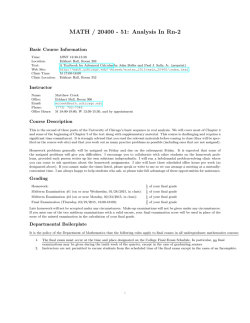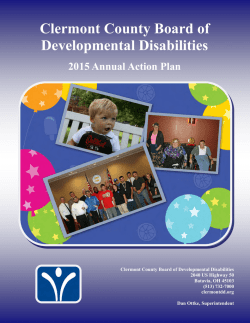
Investigating developmental delay/impairment
SYMPOSIUM: SPECIAL NEEDS Investigating developmental delay/impairment child’s difficulties are temporary and will “catch up”. A recent international consensus conference has proposed early developmental impairment (EDI) as a more appropriate diagnostic term. EDI is defined by the group as persistent significant limitations in two or more developmental domains (motor, communication, cognitive skills, social skills, emotional regulation/behavioural skills, self care skills) with onset before the age of five and not better explained by another established developmental disorder. The group recommends that children are reassessed by school age or before the age of nine to review the diagnosis. We will use the term early developmental impairment for the purposes of this review. Lesley A B McDonald Alison C Rennie Abstract Pre-school children presenting to developmental paediatric services because of concerns that they are not peer-equivalent is a well recognised clinical scenario, and yet the approach to investigation varies widely. Evaluation depends on thorough history taking, careful clinical examination and astute observation of social and play skills. An investigative pathway needs to be evidence-based but also pragmatic; tailored to the child whilst acknowledging the benefit of validated screening tests. Although the overall positive yield is small, it must not be forgotten that negative test results also have value. Both clinician and parents will be reassured by the exclusion of genetic, metabolic and structural aetiologies in their search for answers. It is increasingly acknowledged that there are more subtle presentations of recognised disorders and the new generation of genetic tests and neurological imaging is allowing earlier and more accurate diagnosis. This may afford opportunities for amelioration of the condition in the affected child, together with more accurate genetic counselling for the family and indeed the child themselves. The search for an answer should never stop. Diagnosis Concerns about a child’s developmental progress might be raised by parents, health visitors or general practitioners. Education staff in the pre-school setting may be the first to highlight developmental concerns, particularly as families have less contact with health visitors than in the past. Referral to secondary level Community Child Health services is recommended for detailed evaluation of all children with developmental concerns, as an underlying aetiology may be identified irrespective of the severity of impairment. It is reported that a diagnostic cause can be identified in up to 40e60% of cases, and early diagnosis may improve outcome. A detailed history and careful physical examination are the most important components of the assessment of the child with EDI. One third of aetiological diagnoses made are on the basis of history and examination findings alone. Keywords aetiology; array-based comparative genomic hybridisation (array CGH); early developmental impairment; global developmental delay; guidelines; investigation; multiplex ligation-dependent probe amplification (MLPA); neuroimaging; MRI diffusion tensor imaging; telomeres History A thorough history is essential in the evaluation of children with EDI. Detailed information regarding the pregnancy, delivery and postnatal period should be sought. The mother should be asked about bleeding, gestational diabetes, infection and medical conditions during her pregnancy. Antenatal smoking, alcohol consumption and prescribed and illicit drug use should be documented. Birth details should include onset of labour, mode of delivery, any complications, birth weight, APGAR scores and need for admission to special care. Clear evidence of a neonatal encephalopathy and a significant motor disorder is required before attributing problems to the perinatal period. The child’s medical history should be sought, including medications and immunisations. A full developmental history is required. The age and reason for initial concern should be recorded, along with documentation of milestone attainment. It is important to establish if there has been any developmental regression. The child’s current performance in each domain should be assessed. Parents should also be asked about social interaction and play skills, feeding patterns, and the presence or absence of seizures. A sleep and behaviour history is critical. The family history is important and should include a threegeneration pedigree with note of parental consanguinity, history of miscarriages or neonatal deaths, and family ethnic origin. Features in the history which are predictive of aetiological determination are female gender, abnormal pre or perinatal Definition Global developmental delay (GDD) is commonly encountered in paediatric practice, affecting 1e3% of children under the age of five. It has traditionally been defined as significant delay in two or more developmental domains (gross and fine motor; speech and language; cognition; personal and social; activities of daily living) with “significant” indicating performance two or more standard deviations below the mean on developmental screening or assessment tests. There is agreement however that GDD is an unhelpful term, not least because the word delay implies to parents that their Lesley A B McDonald MBChB MRCP(UK) MRCPCH is an Associate Specialist in Community Paediatrics at the West Centre, Children’s Community Health and Care, 60 Kinfauns Drive, Glasgow, UK. Conflict of interest: none. Alison C Rennie MBChB MRCP(UK) FRCPCH is a Consultant Paediatrician in Neurodisability at Southbank Child Centre, 207 Old Rutherglen Road, Glasgow, UK. Conflict of interest: none. PAEDIATRICS AND CHILD HEALTH 21:10 443 Ó 2011 Elsevier Ltd. All rights reserved. SYMPOSIUM: SPECIAL NEEDS history, antenatal toxin exposure, absence of autistic features, positive family history, parental consanguinity and developmental regression. (MLPA) adds to this detection rate by identifying tiny chromosome deletions and duplications at selected sites such as chromosome telomeres and the sites of known microdeletion and microduplication syndromes such as Angelman/PradereWilli syndromes, Di George syndrome, SmitheMagenis syndrome and the MECP2 microduplication syndrome. It is now commonly agreed that the best test to detect chromosome imbalances in children with developmental impairments is microarray-based comparative genomic hybridisation (array CGH). This high resolution whole genome survey examines the patient’s chromosomes for tiny deletions or duplications of genetic material (also known as copy number variants or CNVs) as small as 100 kb. When array CGH is applied to children with EDI and apparently normal G-banded karyotype, 10e15% will have a pathogenic genomic imbalance of 150e15 000 kb. This greatly improved detection rate, together with the rapidly falling cost of the array CGH analysis, means that most genetic laboratories will soon replace karyotyping with array CGH as the first line investigation of EDI. However, the present wording of laboratory reports is often quite technical and genetics-trained clinicians are required to explain terminology and implications of genomic imbalances to families. A particular interpretive problem concerns small, non-pathogenic CNVs that commonly need to be distinguished from pathogenic CNVs. Family studies are required and even then the results may not be straightforward. Communicating to families such complex results, often of uncertain significance, can be very challenging especially if one or both parents has a learning disability. It should be noted that array CGH cannot detect balanced chromosome rearrangements such as inversions or translocations, nor will it detect small intragenic mutations. The DECIPHER website (http://decipher.sanger.ac.uk) is becoming a very useful clinical resource that is gathering clinical data on the effects of novel genomic imbalances. The Unique Rare Chromosome Disorder Support Group (http://www.rarechromo. org/html/home.asp) also produces excellent leaflets on commoner microdeletion and microduplication syndromes, as well as a leaflet that describes the array CGH technique. Physical examination All children referred with concerns about their development should have a careful physical examination performed. Height, weight and head circumference should be measured and plotted on appropriate growth charts. Parental head circumference should also be measured and plotted and compared to the child’s centile to ensure that relative micro or macrocephaly is not overlooked. The child should be undressed and inspected carefully for neurocutaneous stigmata such as pale patches and cafe au lait spots. Dysmorphic features of the face, ears, hands and feet should be looked for. The spine should be examined for abnormalities and the abdomen palpated to exclude organomegaly. A full neurological examination should be performed, including assessment of cranial nerve function. Tone, power and reflexes should be examined with any asymmetry or focal findings noted. The quality of the child’s movements and gait should be observed and recorded. An eye examination is recommended and may require referral to an ophthalmologist. Assessment of hearing and vision is also necessary. Several studies have shown that children with EDI are at risk of sensory impairment, with disorders of vision in 13e50% and audiological impairments in up to 18%. A formal developmental assessment should be conducted, for example Schedule of Growing Skills or Griffiths Mental Development Scales, in order to accurately determine the child’s current developmental profile. Features on physical examination which are predictive of aetiological determination include microcephaly, macrocephaly, focal neurological findings and the presence of dysmorphic features. Investigations Subsequent to history and examination, if a specific condition is suspected then investigations should be targeted accordingly. One third of diagnoses are made in this way, using investigations to confirm clinical suspicion. Laboratory investigations alone account for a further one third of diagnoses made. Evidence suggests that if diagnosis is not apparent after history and examination, routine karyotyping, fragile X analysis and neuroimaging can result in a diagnosis in one sixth of all cases. Neuroimaging Neuroimaging may detect abnormalities in up to 50% of children with neurodevelopmental disability, with a variable detection rate dependent on factors such as selection criteria and imaging method used. The yield is increased by the presence of abnormal findings on physical examination, for example microcephaly or focal neurological signs. One paper reported a yield of 13.9% from imaging performed on a screening basis, compared to 41.2% if carried out due to a clinical indication. MRI is preferable to CT for the evaluation of children with EDI. MRI findings may include cerebral injury, cerebral malformation, or cerebral dysgenesis, however not all abnormalities found are aetiological in nature. A recent review reported that although abnormal MRI findings were found in approximately 30% of patients with developmental delay or learning disability, these led to an aetiology or syndrome diagnosis in fewer than 4% of cases. MRI is therefore not recommended as a first line investigation, but is useful when used selectively in the presence of abnormal head size, seizures or focal neurological findings. Genetics Genetic abnormalities are among the commonest identifiable causes of EDI. Congenital malformation, microcephaly, short stature and dysmorphism are suggestive features but not specific or obligatory. Associated sensory impairments, unusual behaviour patterns and a family history of a particular condition may also indicate a syndrome diagnosis and prompt referral to the genetics clinic. As far as genetic investigations are concerned, there is consensus that chromosome analysis and Fragile X testing can be employed as screening tests with a detection rate of about 3%. Targeted Multiplex Ligation-Dependent Probe Amplification PAEDIATRICS AND CHILD HEALTH 21:10 444 Ó 2011 Elsevier Ltd. All rights reserved. SYMPOSIUM: SPECIAL NEEDS Further advances in neuroimaging may detect more subtle anomalies. Diffusion tensor imaging is a new MRI technique which uses the pattern of diffusion of water molecules to provide information on tissue structure and white matter tracts. In one study of 20 children with global delay of unknown aetiology and normal MRI, the arcuate fasciculus was absent bilaterally in nine and on the left in another two. In contrast, this tract was present bilaterally in all typically developing children studied. It appears that this tract has a central role in both language and cognitive development and further research is required. Further metabolic testing should be considered if there is a family history of a disorder or of developmental impairment. Other features in the history which warrant consideration include parental consanguinity, developmental regression, congenital ataxia or dysequilibrium, epilepsy or episodic decompensation. Examination findings which may raise clinical suspicion include coarse facial features, growth failure, hepatosplenomegaly, and ophthalmological or retinal abnormalities. Metabolic investigations should also be considered if neonatal screening has not been done, for example in migrant families from developing nations. If metabolic testing is being undertaken, blood should be sent for lactate, amino acids, ammonia, very long chain fatty acids, carnitine, homocysteine and disialotransferrins. A urine sample should also be obtained for organic acids, orotate, glycosaminoglycans and oligosaccharides. Biochemical and haematological investigations There are case reports in the literature of boys with Duchenne muscular dystrophy presenting with early developmental impairment. It is therefore important to measure creatine kinase at an early stage to prevent late or missed diagnosis. Children with developmental problems may have significantly higher blood lead concentration than the general childhood population. We recommend that lead toxicity should be screened for routinely as this neurotoxin may contribute further to impairment and is treatable. Other groups suggest targeting to those with risk factors such as pica, old housing and poor socioeconomic status. Biotinidase deficiency is a treatable disorder which may present as EDI with no other signs or symptoms. Many countries screen for this disorder routinely in the neonatal period, as it is known that early diagnosis and treatment improves outcome. This disorder has a higher incidence in Celtic populations and travelling communities. Abnormalities of plasma calcium may be helpful in the identification of conditions such as Di George syndrome, William’s syndrome and pseudohypoparathyroidism. There is no evidence to support the use of thyroid function testing on a screening basis and some centres state testing is not necessary if newborn screening has been done, unless there are systemic features of hypothyroidism. This condition is however easily treatable with significant implications if the diagnosis is missed. In addition, many chromosome abnormalities are associated with an increased risk of hypothyroidism, for example trisomy 21 (Down’s syndrome), 45X (Turner syndrome) and 22q11 deletion (Di George syndrome). For these reasons we have included thyroid function testing as a first line investigation. Recent reports in the literature suggest that creatine deficiency disorders may be associated with early developmental impairment. It may be necessary to consider routine testing for these disorders in the future. Iron deficiency anaemia may be associated with developmental impairment and is easily measured and treated, so should be screened for routinely. Neurophysiology EEG should not be performed routinely for all children with EDI. If the history is suggestive of seizures or a neurodegenerative disorder then EEG should be considered. It is also important in the evaluation of children with a history of regression in language skills, in order to exclude or diagnose LandaueKleffner syndrome. Guidelines An evidence-based guideline for investigating children with GDD was published in 2006. Publication predated the proposed change in terminology from GDD to EDI. Updated guidance is shown in Figure 1. Management Management of children with EDI may be influenced by the results of any investigations or underlying diagnoses made. For many there will be no cause found for their difficulties; however the benefits of negative testing should not be underestimated as this reassures the family and clinician that serious underlying disorders have been excluded. Management will then focus on maximising the child’s developmental potential. This will vary between children depending on their individual needs, but may include multidisciplinary working with colleagues in physiotherapy, occupational therapy and speech and language therapy. Involvement of education services at an early stage is also useful, in particular for assessment by educational psychology and possible input from a peripatetic pre-school teaching service. Referral to social work should also be considered for family support and assistance with income maximisation, including disability living allowance and Family Fund application as appropriate. Regular review and documentation of developmental progress by the paediatrician is recommended. Metabolic investigations The evidence available does not support the use of metabolic testing on a screening basis. The yield is 1% or less, with a high frequency of non-specific, non-diagnostic abnormalities detected. Investigations should be selective and targeted, with a low threshold for testing if a metabolic disorder is suspected clinically. We have however included urate measurement in our first line investigations as this is an easy way to diagnose purine disorders, which may present as isolated EDI, and is more stable than both ammonia and lactate. PAEDIATRICS AND CHILD HEALTH 21:10 Prognosis Prognosis may also be influenced by the outcome of assessment and investigations, which may in addition give information about recurrence risks for the family. For the child with early developmental impairment with no cause found, giving an accurate prognosis may prove difficult. 445 Ó 2011 Elsevier Ltd. All rights reserved. SYMPOSIUM: SPECIAL NEEDS Specialist Children's Services Department of Community Child Health Early Developmental Impairment in Pre School Children Guidelines for Investigation Early developmental impairment is defined as persistent significant limitations in two or more developmental domains. Investigations should be considered only after a thorough history and examination have been performed. These guidelines are not intended for isolated speech & language or motor problems, or for children with autism. If diagnosis not apparent after history and examination, proceed as follows: First line Chromosomes Fragile X Telomeres Learning disability MLPA U&E Creatine kinase Lead Thyroid function tests Urate Full blood count Ferritin Biotinidase Second line Neuroimaging Abnormal head size Seizures Focal neurology Metabolic Family history Consanguinity Regression Organomegaly Coarse features Blood Lactate Amino acids Ammonia VLCFA Carnitine Homocysteine Urine Organic acids Orotate Gags Oligosaccharides MRI CT (bones, calcification) EEG Speech regression Seizures Neurodegenerative disorder Genetics Dysmorphism Abnormal growth Sensory impairment Odd behaviour Family history Consider 24hr EEG Figure 1 Such children require to be followed up at least until school entry, as the phenotype may change over time and a diagnosis may become apparent. In any event, the term EDI should not stay with the child indefinitely. Reassessment is required at early primary school age to determine whether impairments can be better explained by another established diagnosis or descriptor, such as learning difficulties of unknown aetiology. PAEDIATRICS AND CHILD HEALTH 21:10 Recent and ongoing developments in genetic and neuroimaging techniques are resulting in improved diagnostic yield and better understanding of the underlying disorders associated with early developmental impairment. More subtle presentations of recognised disorders are increasingly being identified by newer screening techniques, allowing earlier diagnosis. 446 Ó 2011 Elsevier Ltd. All rights reserved. SYMPOSIUM: SPECIAL NEEDS Srour M, Mazer B, Shevell M. Analysis of clinical features predicting etiologic yield in the assessment of global developmental delay. Pediatrics 2006; 118: 139e45. Sundaram S, Sivaswamy L, Makki M, Behen M, Chugani H. Absence of arcuate fasciculus in children with global developmental delay of unknown etiology: a diffusion tensor imaging study. J Pediatr 2008; 152: 250e5. van Karnebeek C, Jansweijer M, Leenders A, Offringa M, Hennekam R. Diagnostic investigations in individuals with mental retardation: a systematic literature review of their usefulness. Eur J Med Genet 2005; 13: 6e25. van Karnebeek C, Scheper F, Abeling N, et al. Etiology of mental retardation in children referred to a tertiary care center: a prospective study. Am J Ment Retard 2005; 110: 253e67. Williams J. Global developmental delay e globally helpful? Dev Med Child Neurol 2010; 52: 227. Children and families deserve a systematic and thorough assessment and investigative process. Clinicians should aspire to a uniform approach to ensure best practice standards are followed. A FURTHER READING Essex C, Roper H. Late diagnosis of Duchenne’s muscular dystrophy presenting as global developmental delay. BMJ 2001; 323: 37e8. Francoeur E, Ghosh S, Reynolds K, Robins R. An international journey in search of diagnostic clarity: early developmental impairment. J Dev Behav Pediatr 2010; 31: 338e40. King M, Stephenson J. Delayed Development. In: King M, Stephenson J, eds. A Handbook of Neurological Investigations in Children. London: Mac Keith Press, 2009: 223e7. McDonald L, Rennie A, Tolmie J, Galloway P, McWilliam R. Investigation of global developmental delay. Arch Dis Child 2006; 91: 701e5. Moeschler J. Genetic evaluation of intellectual disabilities. Semin Pediatr Neurol 2009; 15: 2e9. Ozmen M, Tatli B, Aydinli N, Caliskan M, Demirkol M, Kayserili H. Etiologic evaluation in 247 children with global developmental delay at Istanbul, Turkey. J Trop Pediatr 2005; 51: 310e3. Paciorkowski A, Fang M. Chromosomal microarray interpretation: what is a child neurologist to do? Pediatr Neurol 2009; 41: 391e8. Shevell M, Ashwal S, Donley D, et al. Practice parameter: evaluation of the child with global developmental delay. Neurology 2003; 60: 367e80. Shevell M. Global developmental delay and mental retardation or intellectual disability: conceptualization, evaluation and etiology. Pediatr Clin N Am 2008; 55: 1071e84. Shevell M, Majnemer A, Rosenbaum P, Abrahamowicz M. Etiologic yield of subspecialists’ evaluation of young children with global developmental delay. J Pediatr 2000; 136: 593e8. PAEDIATRICS AND CHILD HEALTH 21:10 Practice points C C C C C 447 The term global developmental delay is unhelpful and should be replaced by early developmental impairment. Paediatricians should review departmental practice to ensure best evidence guidelines are being followed. Be aware of new investigative techniques and their relevance in the evaluation of children with EDI. It is important to review diagnoses (and non-diagnoses) in older children who have not had the benefit of newer tests. The search for an underlying aetiology should be an ongoing process. Ó 2011 Elsevier Ltd. All rights reserved.
© Copyright 2025





